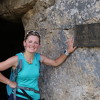
lunar month
The position of the Moon has been resumed every 1,481 minutes, ie 24 hours and 41 minutes. For get a classic analemma, it would have been it is necessary to wait 24 hours and 51 minutes (the rhythm of the lunar month). There is a 10 minute gap. In this way his Moon is always a little "in advance" and this justifies the wider curve: the satellite in the photograph is in fact located a little further to the left of the typical position of the analemma. The advance, which at the end it is about 4 hours between the first day (in top right) and the last (bottom left), not has effect on the lunar phase recovered, at least for this that we can perceive from the ground (enlightenment of the satellite does not vary significantly in this time frame). So, except for the first shot (the one at the top right: as explained before, the chronological progression goes from right to left), the placement of the Moon in the heavenly vault is always farther from that classic. It is therefore a choice: the composition it does not represent the synodic month but "only" the lunar curve, reproducing something that exists really but that does not have a precise definition. For a question of correctness and clarity, I deliberately talked about "lunar curve" e not of "synodic curve" or "lunar analemma" just in reference to the longer time intervals short between shots. It will not be a classic analemma but it is nice.
Giorgia Hofer, Italy, Vigo di Cadore